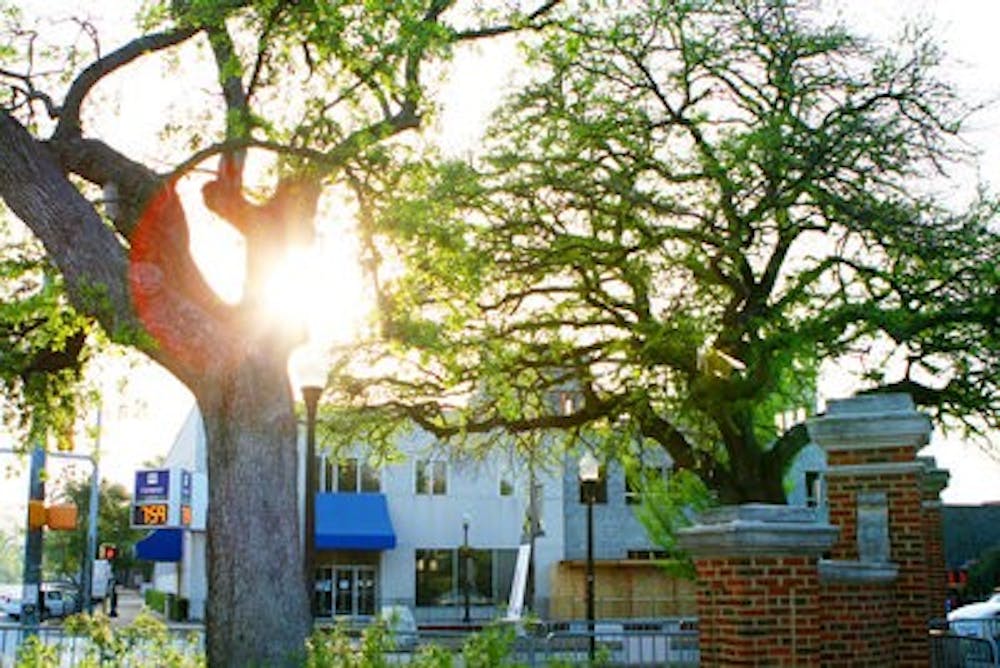The changing of the season has brought new hope to the oaks residing at Toomer's Corner.
Last week Gary Keever, horticulture professor at Auburn University and leader of a group of scientists working to save the trees, observed the canopies of the oaks and saw progress.
"The foliage grown so far this year has not shown signs of the herbicide yet, but it's still early," said Keever, a longtime adviser for the landscape of Toomer's Corner and an official consultant for the trees the last five and a half years.
"Does it mean they are going to survive? Absolutely not. If there is still herbicide in the root zone, the tree is going to take it right to the new leaves. There's reason to be encouraged, but there's no reason to be overly optimistic."
Minimizing the stress on the oaks involves many different facets of care, but the next step is injecting the trunks of the trees with a sugar solution.
Saturday, a company from Tennessee will use a reservoir of a sugar solution with tubes running into the trunks. Keever likened the process to a human receiving an IV. The sugar will replace the carbohydrates the trees have used in their battle to grow new foliage.
The sugar solution has been used before on healthy trees, but it is not an automatic fix.
"The only work done on this was done in 2009 where they injected the sugar into healthy trees, and our trees are anything but healthy," Keever said. "We will use low pressure to gently force it into the trunk. We might be able to force it a little, but not much. The question is, will these trees take on this solution with as little foliage as there is?"
After the sugar solution, Keever and his team will continue to work on keeping the trees alive--Keever's only concern.
"We're going to inject the sugar solution; we're going to continue to fertilize; we're going to prune the trees," he said. "We're going to test the soil, and beyond that, we're going to irrigate in any dry spells."
The committee deciding the future of the Toomer's Oaks is not letting the new foliage change its plans.
"If the trees by some chance live, then there would not be a need for us to find another location to roll, which would be great news," said Debbie Shaw, chairperson for the Committee to Determine the Future of Rolling Toomer's Corner. "However, since the chances are still relatively slight, it is important we continue with our backup plan regarding the Toomer's Corner rolling tradition."
With the uncertainty regarding the trees' future, Shaw knows one thing for sure: there will be toilet paper flying on the corner in the fall.
"We do plan to roll the trees this fall, even if the trees were to die," Shaw said. "We have been assured by horticulturists that will be OK. But because the results of the survey we conducted this past fall showed that people feel that continuing the rolling tradition is very important, we know we must be ready for the day that the trees might not be around."
Keever said ideally the oaks wouldn't need pruning at all, but the wood that has already died could become hazardous. Keever said the oaks have been through a plaza renovation and one major limb removal a few years ago and have been regressing for a number of years.
"This tree has been declining for many years," Keever said, "and we're going to have to take a lot of wood off of it. And if you go up there now and photograph this tree, you'll see there are quite a few limbs with no leaves on them. In most cases, that wood is dead."
Keever said the trees may become "aesthetically dead" if too much is removed, and at that point his hand will be forced.
"Let's say we remove 80 percent of the canopy," Keever said. "I would be inclined to make the recommendation the tree be removed. It's no longer an asset, but a liability."
Keever thinks any other oaks would have been removed by this point.
"Anywhere else on campus that tree probably would have been taken out already," Keever said. "But because it's one of the Toomer's Oaks we haven't really considered (removing) it.
"With special trees, it's about more than the appearance of tree. It's about what it means and the symbolism of the tree."
Do you like this story? The Plainsman doesn't accept money from tuition or student fees, and we don't charge a subscription fee. But you can donate to support The Plainsman.





